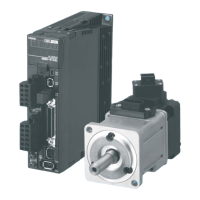3-81
3-3 Motor Specifications
Accurax G5 AC SERVOMOTOR AND SERVO DRIVE USER'S MANUAL
3
Specifications
*1. These are the values when the motor is combined with a driver at normal temperature (20°C, 65%). The momentary
maximum torque indicates the standard value.
*2. Applicable load inertia.
The operable load inertia ratio (load inertia/rotor inertia) depends on the mechanical configuration and
its rigidity. For a machine with high rigidity, operation is possible even with high load inertia. Select an
appropriate motor and confirm that operation is possible.
If the dynamic brake is activated frequently with high load inertia, the Dynamic Brake Resistor may burn.
Do not repeatedly turn the servo ON/OFF while the dynamic brake is enabled.
*3. The allowable radial and thrust loads are the values determined for a limit of 20,000 hours at normal operating
temperatures.
The allowable radial loads are applied as shown in the following diagram.
*4. This is a non-excitation brake. (It is released when excitation voltage is applied.)
*5. The operation time is the value (reference value) measured with a surge suppressor (CR50500 by Okaya Electric
Industries Co., Ltd.).
*6. Direct current switching with a varistor (TNR9G820K by Nippon Chemi-Con Corporation).
*7. Direct current switching with a varistor (Z15D151 by Ishizuka Electronics Co.).
Torque-Rotation Speed Characteristics for 1,000-r/min Motors
1,000-r/min motor (200/400 VAC)
The following graphs show the characteristics with a 3-m standard cable and a 200-VAC input.
• R88M-K90010H/T/F/C • R88M-K2K010H/T/F/C • R88M-K3K010H/T/F/C
(100 W) (2 kW) (3 kW)
Temperature Characteristics of the Motor and Mechanical System
OMNUC G5-Series AC Servomotors use rare earth magnets (neodymium-iron magnets). The
temperature coefficient for these magnets is approx. -0.13%/
°C.
As the temperature drops, the motor's momentary maximum torque increases, and as the
temperature rises, the motor's momentary maximum torque decreases.
The momentary maximum torque rises by 4% at a normal temperature of 20
°C compared to a
temperature of -10
°C. Conversely, the momentary maximum torque decreases about 8% when
the magnet warms up to 80
°C from the normal temperature.
Generally, when the temperature drops in a mechanical system, the friction torque and the load
torque increase. For that reason, overloading may occur at low temperatures.
In particular, in systems that use a gearbox, the load torque at low temperatures may be nearly
twice as much as the load torque at normal temperatures.
Check whether overloading may occur during starting at low temperature.
25
0
50
1000
2000
(r/min)
19.119.1
47.7 (1600)47.7
28.0
18.0
9.6
(1400)
Power supply voltage
dropped by 10%
Continuous operation range
Momentary operation range
(N • m)
10
0
20
19.3 (1800)
19.3
8.598.59
1000
2000
(r/min)
14.0
8.0
4.3
(1600)
Power supply voltage
dropped by 10%
Continuous operation range
Momentary operation range
(N • m)
25
0
50
1000
2000
(r/min)
19.119.1
47.7 (1600)47.7
28.0
18.0
9.6
(1400)
Power supply voltage
dropped by 10%
Continuous operation range
Momentary operation range
(N • m)
35
0
70
1000
2000
(r/min)
28.728.7
71.7 (1600)71.7
40.0
20.0
14.0
(1400)
Power supply voltage
dropped by 10%
(N • m)
Continuous operation range
Momentary operation range

